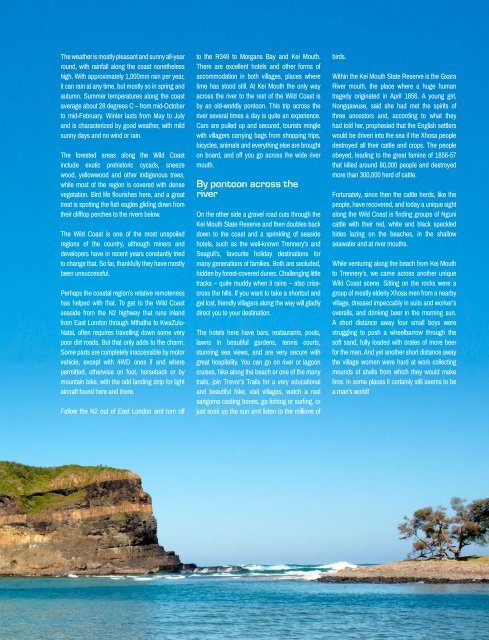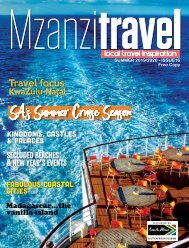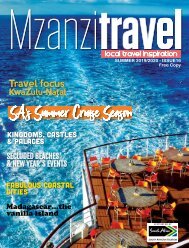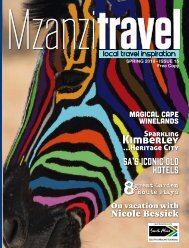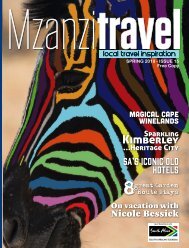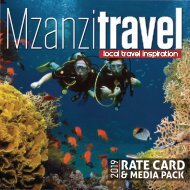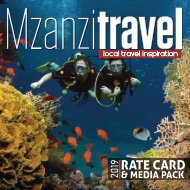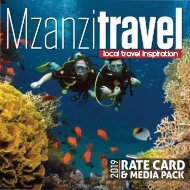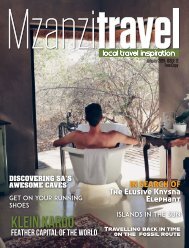Create successful ePaper yourself
Turn your PDF publications into a flip-book with our unique Google optimized e-Paper software.
The weather is mostly pleasant and sunny all-year<br />
round, with rainfall along the coast nonetheless<br />
high. With approximately 1,000mm rain per year,<br />
it can rain at any time, but mostly so in spring and<br />
autumn. Summer temperatures along the coast<br />
average about 28 degrees C – from mid-October<br />
to mid-February. Winter lasts from May to July<br />
and is characterized by good weather, with mild<br />
sunny days and no wind or rain.<br />
The forested areas along the Wild Coast<br />
include exotic prehistoric cycads, sneeze<br />
wood, yellowwood and other indigenous trees,<br />
while most of the region is covered with dense<br />
vegetation. Bird life flourishes here, and a great<br />
treat is spotting the fish eagles gliding down from<br />
their clifftop perches to the rivers below.<br />
The Wild Coast is one of the most unspoiled<br />
regions of the country, although miners and<br />
developers have in recent years constantly tried<br />
to change that. So far, thankfully they have mostly<br />
been unsuccessful.<br />
Perhaps the coastal region’s relative remoteness<br />
has helped with that. To get to the Wild Coast<br />
seaside from the N2 highway that runs inland<br />
from East London through Mthatha to KwaZulu-<br />
Natal, often requires travelling down some very<br />
poor dirt roads. But that only adds to the charm.<br />
Some parts are completely inaccessible by motor<br />
vehicle, except with 4WD ones if and where<br />
permitted, otherwise on foot, horseback or by<br />
mountain bike, with the odd landing strip for light<br />
aircraft found here and there.<br />
Follow the N2 out of East London and turn off<br />
to the R349 to Morgans Bay and Kei Mouth.<br />
There are excellent hotels and other forms of<br />
accommodation in both villages, places where<br />
time has stood still. At Kei Mouth the only way<br />
across the river to the rest of the Wild Coast is<br />
by an old-worldly pontoon. This trip across the<br />
river several times a day is quite an experience.<br />
Cars are pulled up and secured, tourists mingle<br />
with villagers carrying bags from shopping trips,<br />
bicycles, animals and everything else are brought<br />
on board, and off you go across the wide river<br />
mouth.<br />
By pontoon across the<br />
river<br />
On the other side a gravel road cuts through the<br />
Kei Mouth State Reserve and then doubles back<br />
down to the coast and a sprinkling of seaside<br />
hotels, such as the well-known Trennery’s and<br />
Seagull’s, favourite holiday destinations for<br />
many generations of families. Both are secluded,<br />
hidden by forest-covered dunes. Challenging little<br />
tracks – quite muddy when it rains – also crisscross<br />
the hills. If you want to take a shortcut and<br />
get lost, friendly villagers along the way will gladly<br />
direct you to your destination.<br />
The hotels here have bars, restaurants, pools,<br />
lawns in beautiful gardens, tennis courts,<br />
stunning sea views, and are very secure with<br />
great hospitality. You can go on river or lagoon<br />
cruises, hike along the beach or one of the many<br />
trails, join Trevor’s Trails for a very educational<br />
and beautiful hike, visit villages, watch a real<br />
sangoma casting bones, go fishing or surfing, or<br />
just soak up the sun and listen to the millions of<br />
birds.<br />
Within the Kei Mouth State Reserve is the Gxara<br />
River mouth, the place where a huge human<br />
tragedy originated in April 1856. A young girl,<br />
Nongqawuse, said she had met the spirits of<br />
three ancestors and, according to what they<br />
had told her, prophesied that the English settlers<br />
would be driven into the sea if the Xhosa people<br />
destroyed all their cattle and crops. The people<br />
obeyed, leading to the great famine of 1856-57<br />
that killed around 80,000 people and destroyed<br />
more than 300,000 herd of cattle.<br />
Fortunately, since then the cattle herds, like the<br />
people, have recovered, and today a unique sight<br />
along the Wild Coast is finding groups of Nguni<br />
cattle with their red, white and black speckled<br />
hides lazing on the beaches, in the shallow<br />
seawater and at river mouths.<br />
While venturing along the beach from Kei Mouth<br />
to Trennery’s, we came across another unique<br />
Wild Coast scene. Sitting on the rocks were a<br />
group of mostly elderly Xhosa men from a nearby<br />
village, dressed impeccably in suits and worker’s<br />
overalls, and drinking beer in the morning sun.<br />
A short distance away four small boys were<br />
struggling to push a wheelbarrow through the<br />
soft sand, fully loaded with crates of more beer<br />
for the men. And yet another short distance away<br />
the village women were hard at work collecting<br />
mounds of shells from which they would make<br />
lime. In some places it certainly still seems to be<br />
a man’s world!


